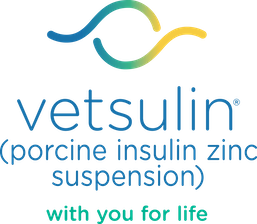

Etiology
Read More About Feline Diabetes
The Cause & Condition of Feline Diabetes
Primary Causes of Diabetes Mellitus
The most common causes of diabetes in cats are obesity, pancreatitis, and most frequently, amyloidosis of the pancreatic beta cells. There appears to be very little gender predisposition to this disease in cats, although it is slightly more common in males than females. As with dogs, the onset of diabetes in cats occurs most often in middle age.
In addition, stress, obesity, and administration of corticosteroids or progestogens may increase the severity of clinical signs.
Secondary Causes of Feline Diabetes
Diabetes mellitus can be secondary to severe inflammation or neoplasia of exocrine pancreatic tissue, which leads to loss of islet function. In these cases, diabetes is also complicated by exocrine pancreatic insufficiency. Diabetes mellitus can also occur when there is either overproduction of counteracting hormones or insulin resistance. Excessive growth hormone production can be seen in intact, cycling females. Progesterone produced during the luteal phase of the estrous cycle induces the production of growth hormone by the mammary gland, which counteracts the action of insulin.
There are many pathogenic mechanisms responsible for decreased insulin production and secretion, but they are usually related to destruction of islet cells. While dogs tend to develop diabetes mellitus secondary to either immune destruction of the pancreatic beta cells or severe pancreatitis, cats tend to develop diabetes mellitus secondary to pancreatitis or amyloidosis.
Chronic relapsing pancreatitis with progressive loss of both exocrine and endocrine cells and their replacement by fibrous connective tissue results in diabetes mellitus. The pancreas becomes firm and multinodular and often contains scattered areas of hemorrhage and necrosis. As the disease progresses, a thin, fibrous band of tissue near the duodenum and stomach may be all that remains of the pancreas.
Selective infiltration of islets with amyloid, glycogen, and collagen with destruction of islet cells has been reported in cats with diabetes. The numbers of beta cells decrease, and the cells become vacuolated. In chronic cases, the islets are difficult to find.
Obesity also predisposes cats to insulin resistance. In obese cats, tissue receptors have decreased insulin sensitivity. This leads to a greater demand for insulin, which can result in exhaustion of the islets of Langerhans.
Help Your Practice Manage Diabetes Mellitus
Check out these tools and resources to help manage feline diabetes.

Blood Glucose Curve Generator
Create a blood glucose curve to monitor and evaluate diabetes treatments.

Client Discharge Form
Create a customized, printable form for clients about their new diagnosis.

Diabetes Resources
Access online tools and more to support staff and pet parents.
No items to show.
Read More About Feline Diabetes
Important Safety Information:
Vetsulin® should not be used in dogs known to have a systemic allergy to pork or pork products. Vetsulin is contraindicated during periods of hypoglycemia. Keep out of reach of children. As with all insulin products, careful patient monitoring for hypoglycemia and hyperglycemia is essential to attain and maintain adequate glycemic control and prevent associated complications. Overdosage can result in profound hypoglycemia and death. The safety and effectiveness of Vetsulin in puppies, breeding, pregnant, and lactating dogs has not been evaluated. See package insert for full information regarding contraindications, warnings, and precautions.
References:
1. Martin GJ, Rand JS. Pharmacology of a 40 IU/ml porcine lente insulin preparation in diabetic cats: findings during the first week and after 5 or 9 weeks of therapy. J Feline Med Surg. 2001;3(1):23–30. 2. Vetsulin® (porcine insulin zinc suspension) [Freedom of Information Summary]. Millsboro, DE: Intervet Inc.; 2008. 3. Data on file, Merck Animal Health. 4. Graham PA, Nash AS, McKellar QA. Pharmacokinetics of porcine insulin zinc suspension in diabetic dogs. J Small Anim Pract. 1997;38(10):434–438. 5. Martin GJ, Rand JS. Pharmacokinetic and Pharmacodynamic Study of Caninsulin in Cats with Diabetes Mellitus. 2000: Internal Study Report. 6. Feldman EC, Nelson RW. Canine and Feline Endocrinology and Reproduction. 3rd ed. St. Louis, MO: Saunders; 2004:539–579. 7. Tennant B, ed. BSAVA Small Animal Formulary. 4th ed. Gloucestershire, UK: British Small Animal Veterinary Association; 2002. 8. Feldman EC, Nelson RW. Canine and Feline Endocrinology and Reproduction. 3rd ed. St. Louis, MO: Saunders; 2004:486–538. 9. Reusch C. Feline diabetes mellitus. In: Ettinger SJ, Feldman EC, eds. Textbook of Veterinary Internal Medicine. 7th ed. St. Louis, MO: Saunders; 2010:1796–1816. 10. Nelson RW. Canine diabetes mellitus. In: Ettinger SJ, Feldman EC, eds. Textbook of Veterinary Internal Medicine. 7th ed. St. Louis, MO: Saunders; 2010:1782–1796. 11. Burgaud S, Riant S, Piau N. Comparative laboratory evaluation of dose delivery using a veterinary insulin pen. In: Proceedings of the WSAVA/FECAVA/BSAVA congress; 12–15 April 2012; Birmingham, UK. Abstract 121. 12. Burgaud S, Guillot R, Harnois-Milon G. Clinical evaluation of a veterinary insulin pen in diabetic dogs. In: Proceedings of the WSAVA/ FECAVA/BSAVA congress; 12–15 April 2012; Birmingham, UK. Abstract 122. 13. Burgaud S, Guillot R, Harnois-Milon G. Clinical evaluation of a veterinary insulin pen in diabetic cats. In: Proceedings of the WSAVA/FECAVA/BSAVA congress; 12–15 April 2012; Birmingham, UK. Abstract 45. 14. Davison LJ, Walding B, Herrtage ME, Catchpole B. Anti-insulin antibodies in diabetic dogs before and after treatment with different insulin preparations. J Vet Intern Med. 2008;22:1317-1325. 15. Banfield State of Pet Health 2016 Report. p 12-13.
